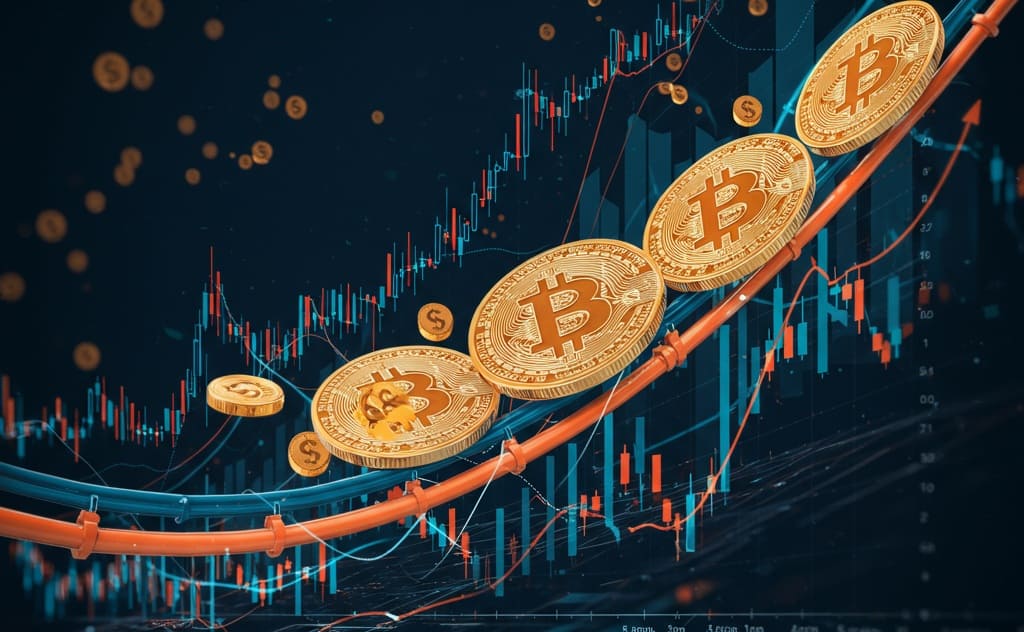Bitcoin’s Rollercoaster: A Year in Review and What Lies Ahead
Bitcoin the undisputed king among cryptocurrencies, has proven its unpredictable and captivating characteristics throughout the past year. From May 2024 until May 2025, the price chart has been a testimony to the changing market dynamics along with institutional adoption, as well as changing macroeconomic landscapes. Understanding the fluctuations in these charts is essential for anyone navigating the digital asset market. We will also get an overview of the Bitcoin Price Prediction for the next 5 years.
A Year of Dynamic Swings: Bitcoin’s Price Fluctuation (May 2024 – May 2025)
The past twelve months have witnessed Bitcoin begin a fascinating trip, marked by massive rises, sharp corrections and a steady upward trend that is advancing towards new record-setting records.
The month of April 2024, Bitcoin started the period of trading near the $60,000 mark, and ended the month around $67,000. It was a fairly steady period after the expectation for Bitcoin Halving in April 2024. Bitcoin Halving event in April 2024, which had introduced some positive sentiment.
Summer months in June and July as well as August of 2024 witnessed Bitcoin grow and then experience some downward pressure. Prices fluctuated between $67,000 and $58,000 with July seeing a minor rebound, and August seeing the onset of a drop. This was probably caused by the consolidation of markets in general as well as a reversal from the initial post-halving effects.
As we entered the months of September into October and September 2024, Bitcoin began to demonstrate signs of a renewed vigor rising from about $58,000 up to $70,000. The momentum for growth accelerated during November of 2024 as Bitcoin increasing from around $70,000, to close around $96,000. A major change in market sentiments marked the period due to the growing anticipation of possible approvals by the regulators of Bitcoin Spot Bitcoin ETFs (ETFs) that are available in the United States.
The month of December in 2024 maintained the upward trend and saw Bitcoin climbing to a staggering peak of $108,000 before falling to around $93,000 at the end of the month. The excitement of ETF approvals was evident and drew in a significant amount of capital.
The excitement reached its peak during the month of January in 2025 when Bitcoin rose to an unimaginable record-breaking high of close to $109,000. The surge was directly associated to the historic approvals of a number of Spot Bitcoin ETFs in the U.S., opening the doors for both retail and institutional investors to be exposed to Bitcoin via regulated channels. The excitement, however, was only for a short time.
Between February and March of 2025, the market saw a significant correction. Bitcoin fell from its peak dropping to $84,000 in February, and then settling at lows of around $78,000 during March. The decline is attributed to the combination of profit-taking following the rapid rise and macroeconomic concerns, along with certain security issues that affected major exchanges that briefly reduced the confidence of investors.
Yet, Bitcoin demonstrated its resilience through the months of April 2025 and May 2025. After dipping to $74,000 in April, the currency experienced a significant rebound increasing steadily, gaining $94,000 by the end April. It then soared to $106,000 by the end of May, even reaching the mark of $109,000. The recent rebound highlights the strength of the asset and continues interest by institutions for the asset.
Top 5 Cryptocurrencies to Watch in 2025: What Experts Are Saying
Unpacking the Drivers: Reasons for Bitcoin’s Price Fluctuation
Bitcoin’s price movements aren’t random. They are the result of a complicated interplay between various external and fundamental elements:
- Demand and Demand Dynamics: The fundamentals of the price of Bitcoin, just like every other asset, is determined by demand and supply. The finite supply limit at 21 million dollars as well as a planned decrease in the number of coins issued (halving events) result in a scarcity that is inherent. If the demand exceeds the supply, the price is likely to increase.
- Bitcoin Halving Event: The most recent Halving took place on April 19th, 2024. It reduced the price of mining blocks down from 6.25 BTC to 3.125 BTC. In the past, halvings have reduced the speed at which new Bitcoin that are released into circulation, which causes the possibility of a supply shock which often precedes a significant price increase during the time following the incident. While the immediate effect might not be a clear price rise, the long-term deflationary pressure is an important bearish element.
- Institutional ETF Inflows and Investments: The approval of Spot Bitcoin ETFs in January 2024 marked a major shift in the market. These funds provide a safe and easy way for large hedge funds, major institutions as well as traditional investors to be exposed to Bitcoin without owning the currency. The significant inflows into ETFs, which are particularly apparent between 2024 and 2025, are an important driver for demand. Corporate adoption, like MicroStrategy or Japan’s Metaplanet including substantial Bitcoin on their books, proves the role of Bitcoin as a stable asset.
- Regulations and Developments: Government regulations and policies have a profound impact on Bitcoin’s price. Positive regulatory environments, such as that of the Securities and Exchange Commission’s ETF approvals or crypto-friendly policy positions (such as those expected by Trump’s administration Trump administration) are able to boost confidence and inspire the investment. On the other hand, restrictive policies or bans that are completely unjust could trigger sales.
- Macroeconomic Factors Global economic developments, such as the rate of inflation and central bank monetary policies as well as geopolitical tensions have a significant impact on the behavior of investors. Bitcoin is frequently viewed to be “digital gold” – a security against rising inflation and economic instability. In times of high inflation or economic instability investors can choose Bitcoin as a source of worth, thereby increasing the price.
- Market news and sentiment: Public perception, headlines in the news, and social media trends can quickly influence the market’s sentiment. The positive effects of celebrity endorsements or technological advances that are major can trigger FOMO (Fear of Losing Out) and price spikes. In the event of negative news, for example hacks to exchanges or crackdowns on regulatory policies or panic selling. The actions that occurs among “whales” – large Bitcoin holders – can also play an important role, since their massive buy and sell orders could affect the market.
- Technological advancements: Ongoing developments and enhancements on the Bitcoin blockchain, like scaling solutions or new apps that are built on the network can increase its utility and appeal, positively affecting the price of Bitcoin.
The Recent Surge: Why Bitcoin Hit Highs in March, April, and May 2025
The exceptional performance of Bitcoin over the past 2 to 3 months could be explained by a combination of the above-mentioned factors with particular focus on:
- Sustained Demand from Institutions and ETF Inflows Following the initial excitement post-ETF approval and then a correction, institutional funds continued to pour into Spot Bitcoin ETFs at a rapid rate. There are reports of billions of dollars in new capital flowing into these funds, which indicates the growing confidence of large investors. This constant buying pressure gives a high demand floor.
- Corporate Accumulation In addition to ETFs and publicly traded firms such as MicroStrategy and Metaplanet have been able to invest strategically in Bitcoin by adding the cryptocurrency to their corporate Treasury accounts. This is evidence of the rising pattern of Bitcoin being accepted as a valid reserve asset.
- bullish Futures Market Sentiment: A high level of market interest Bitcoin futures markets suggests that traders are betting on a continued uptrend in price. This leveraged buying could boost price fluctuations.
- Affordable Macroeconomic outlook (Perceived): A perceived ease in trade tensions in the world, combined with a rise in the M2’s money supply has led to a risk-averse atmosphere. This is why Bitcoin’s stable supply is a great security against the possibility of debasement of fiat currencies.
- The anticipation of future catalysts While they aren’t yet in the process of being realized the speculation of the future is fueling optimism. It is possible of BRICS nations to declare a new gold and Bitcoin-backed payment system for the world, major tech companies such as Apple, Tesla, and Google in addition to Bitcoin on their books, or even an International Monetary Fund (IMF) could include Bitcoin as a part of a new reserve basket for the world. If they do occur, would drastically boost the adoption of Bitcoin and its perceived value.
The Road Ahead: Bitcoin Price Prediction by Next 5 Years (Up to 2030)
Predicting the value of Bitcoin’s currency is difficult due to its high fluctuations and the myriad of factors that influence it. However, a number of experts and models can provide impressive long-term forecasts that are generally suggesting a steady growth.
Here’s an analysis of the predicted price range of Bitcoin in 2030, based on a variety of studies:
- 2025 The majority of forecasts for 2025’s end are between between $115,000 and $250,000. Certain more extreme forecasts specifically from options market sentiment indicate a chance of hitting $300,000 by the end of June 2025. Some of the factors that support this include continuing ETF inflows, a growing increase in companies’ adoption of ETFs and a waning market.
- 2026-2027 It is widely believed that there will be an ongoing bullish trend however, there are potential times of consolidating. The predictions for this time period range between 95,000-$160,000 Some analysts predicting it could reach $200,000.. The rate of clarity in regulatory regulations and the stability of the global economy will play a key role.
- 2028-2029 The next Bitcoin halves approach (expected to occur around April 2028) The supply shock story will probably get more attention. The forecasts for this time period are more diverse, however, they tend to be higher. They range between $74,000-$400,000. Some forecasts are optimistic, placing it within the $350,000 to $400,000 range by 2029.
- 2030 It is at this point that the predictions get more ambitious, indicating the conviction in Bitcoin’s value concept and growing acceptance into global finance. While certain models based on growth rates that are conservative project prices of around $136,000 however, many well-known figures and institutions predict much higher numbers:
- $400,000 to $600,000. (implied in Robert Kiyosaki’s 2035 forecast)
- $975,000 (Benzinga)
- $1,000,000 (Joe Burnett of Unchained, Samson Mow, Jack Dorsey)
- $1.5 Million to $2.4 Million (Cathie Wood’s ARK Invest bull case)
These optimistic long-term forecasts are based on the conviction that Bitcoin will remain in the ascendancy as a reserve asset for the world as a hedge against inflation, as well as a key layer of financial services that are decentralized. Factors like a decreasing U.S. dollar, continued adoption by institutions, and rising convergence of DeFi with traditional financial institutions are thought to be strong factors.
Conclusion
The last year is a microcosmos of the journey of Bitcoin: periods of thrilling growth, interspersed with needed corrections that are triggered by a complicated interplay of demand-supply dynamics, technological advances and regulatory changes, as well as macroeconomic factors. The recent spike in April, March, and May 2025 highlights the increasing interest of institutions and the enduring story of Bitcoin as a rare and highly valuable digital asset.
Although the road ahead will certainly come with many challenges and volatility, the long-term prospects for Bitcoin remains extremely positive. As it matures and become a part of the financial ecosystem of the world Many believe that its path toward being a global secure store of value that is not subject to censorship is just beginning, with targets for price that range from hundreds of thousands or even millions in 5 years. For investors, knowing the underlying factors and keeping an outlook for the future is essential to navigate Bitcoin’s bright future.








One Comment